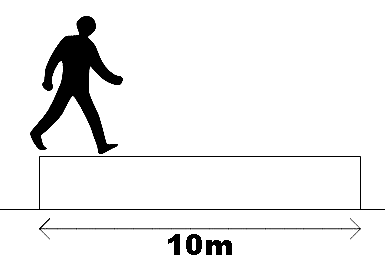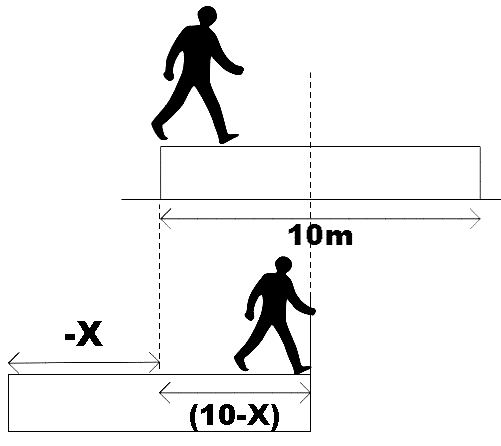
A wooden plank of mass 20kg is resting on a smooth horizontal floor. A man of mass 60kg starts moving from one end of the plank to the other end. The length of the plank is 10m. Find the displacement of the plank over the floor when the man reaches the other end of the plank.


Answer
558.9k+ views
Hint: You could firstly represent the given situation in a neat diagram. Now take the displacement of the plank as x then, the displacement of the man will be 10-x. Then, you could recall the expression for net displacement of the system, and then substituting accordingly will give you the required displacement.
Formula used:
The net displacement of the system,
$S=\dfrac{{{m}_{1}}{{r}_{1}}+{{m}_{2}}{{r}_{2}}}{{{m}_{1}}+{{m}_{2}}}$
Complete step-by-step solution
In the question, we are given a 20kg wooden plank that lies on a smooth floor. A 60kg man walks across this plank of 10m. We are asked to find the displacement of the plank over the floor as the man reaches the other end of the plank. So the situation is as represented below,

As the floor is smooth, there will be no friction, also, there is no mention of any external force, so, the net displacement of the center of mass should be zero.
We know that the net displacement of the center of mass of the system is given by,
$S=\dfrac{{{m}_{1}}{{r}_{1}}+{{m}_{2}}{{r}_{2}}}{{{m}_{1}}+{{m}_{2}}}$
Here, ${{m}_{1}}$ is the mass of the plank, ${{m}_{2}}$ is the mass of the man, ${{r}_{1}}$ is the displacement of the scale and ${{r}_{2}}$ is the displacement of the man.
Substituting according gives,
$S=\dfrac{20\times \left( -x \right)+60\times \left( 10-x \right)}{20+60}$
But, net displacement of the centre of mass of the system is zero here, so,
$\dfrac{20\times \left( -x \right)+60\times \left( 10-x \right)}{20+60}=0$
$\Rightarrow -20x+600-60x=0$
$\Rightarrow 80x=600$
$\therefore x=\dfrac{600}{80}=7.5m$
Therefore, the displacement of the plank over the floor when the man reaches the other end of the plank is found to be 7.5m.
Note: If you are wondering why we have taken negative signs for the displacement of the plank, it is to symbolize the displacement of the plank opposite to the displacement of man. Relating the situation to some real-life experience you will realize that this is exactly what happens in such a situation. Hence the negative sign.
Formula used:
The net displacement of the system,
$S=\dfrac{{{m}_{1}}{{r}_{1}}+{{m}_{2}}{{r}_{2}}}{{{m}_{1}}+{{m}_{2}}}$
Complete step-by-step solution
In the question, we are given a 20kg wooden plank that lies on a smooth floor. A 60kg man walks across this plank of 10m. We are asked to find the displacement of the plank over the floor as the man reaches the other end of the plank. So the situation is as represented below,

As the floor is smooth, there will be no friction, also, there is no mention of any external force, so, the net displacement of the center of mass should be zero.
We know that the net displacement of the center of mass of the system is given by,
$S=\dfrac{{{m}_{1}}{{r}_{1}}+{{m}_{2}}{{r}_{2}}}{{{m}_{1}}+{{m}_{2}}}$
Here, ${{m}_{1}}$ is the mass of the plank, ${{m}_{2}}$ is the mass of the man, ${{r}_{1}}$ is the displacement of the scale and ${{r}_{2}}$ is the displacement of the man.
Substituting according gives,
$S=\dfrac{20\times \left( -x \right)+60\times \left( 10-x \right)}{20+60}$
But, net displacement of the centre of mass of the system is zero here, so,
$\dfrac{20\times \left( -x \right)+60\times \left( 10-x \right)}{20+60}=0$
$\Rightarrow -20x+600-60x=0$
$\Rightarrow 80x=600$
$\therefore x=\dfrac{600}{80}=7.5m$
Therefore, the displacement of the plank over the floor when the man reaches the other end of the plank is found to be 7.5m.
Note: If you are wondering why we have taken negative signs for the displacement of the plank, it is to symbolize the displacement of the plank opposite to the displacement of man. Relating the situation to some real-life experience you will realize that this is exactly what happens in such a situation. Hence the negative sign.
Recently Updated Pages
Why are manures considered better than fertilizers class 11 biology CBSE

Find the coordinates of the midpoint of the line segment class 11 maths CBSE

Distinguish between static friction limiting friction class 11 physics CBSE

The Chairman of the constituent Assembly was A Jawaharlal class 11 social science CBSE

The first National Commission on Labour NCL submitted class 11 social science CBSE

Number of all subshell of n + l 7 is A 4 B 5 C 6 D class 11 chemistry CBSE

Trending doubts
1 Quintal is equal to a 110 kg b 10 kg c 100kg d 1000 class 11 physics CBSE

Why is steel more elastic than rubber class 11 physics CBSE

What is boron A Nonmetal B Metal C Metalloid D All class 11 chemistry CBSE

What is Environment class 11 chemistry CBSE

Bond order ofO2 O2+ O2 and O22 is in order A O2 langle class 11 chemistry CBSE

How many squares are there in a chess board A 1296 class 11 maths CBSE




